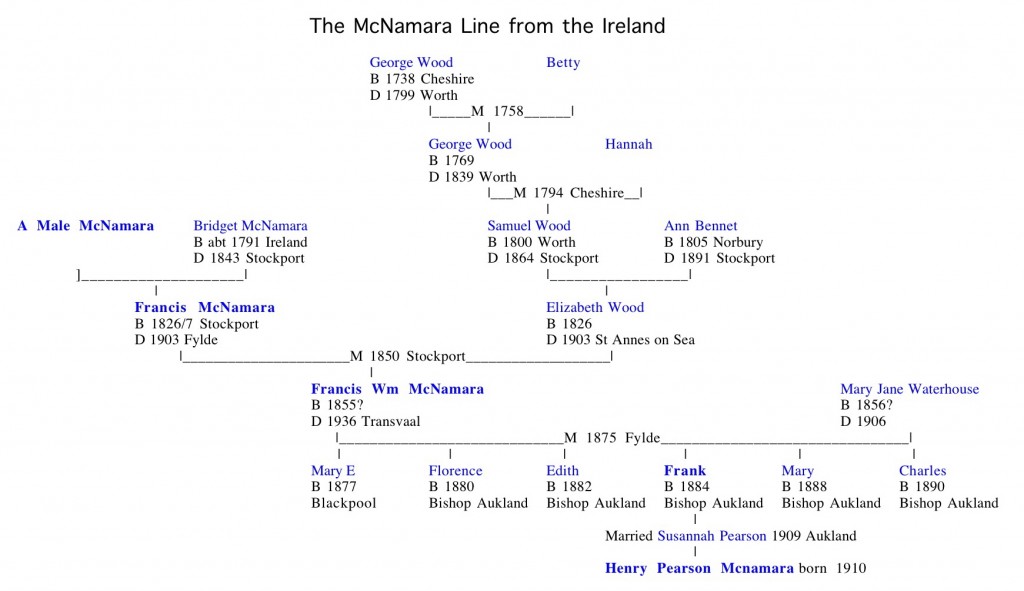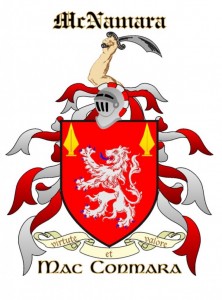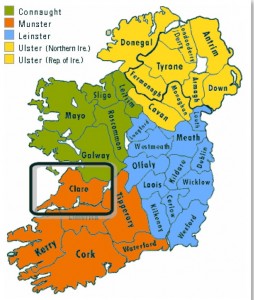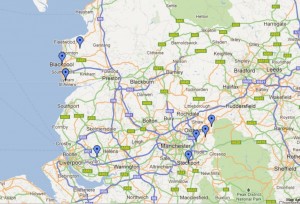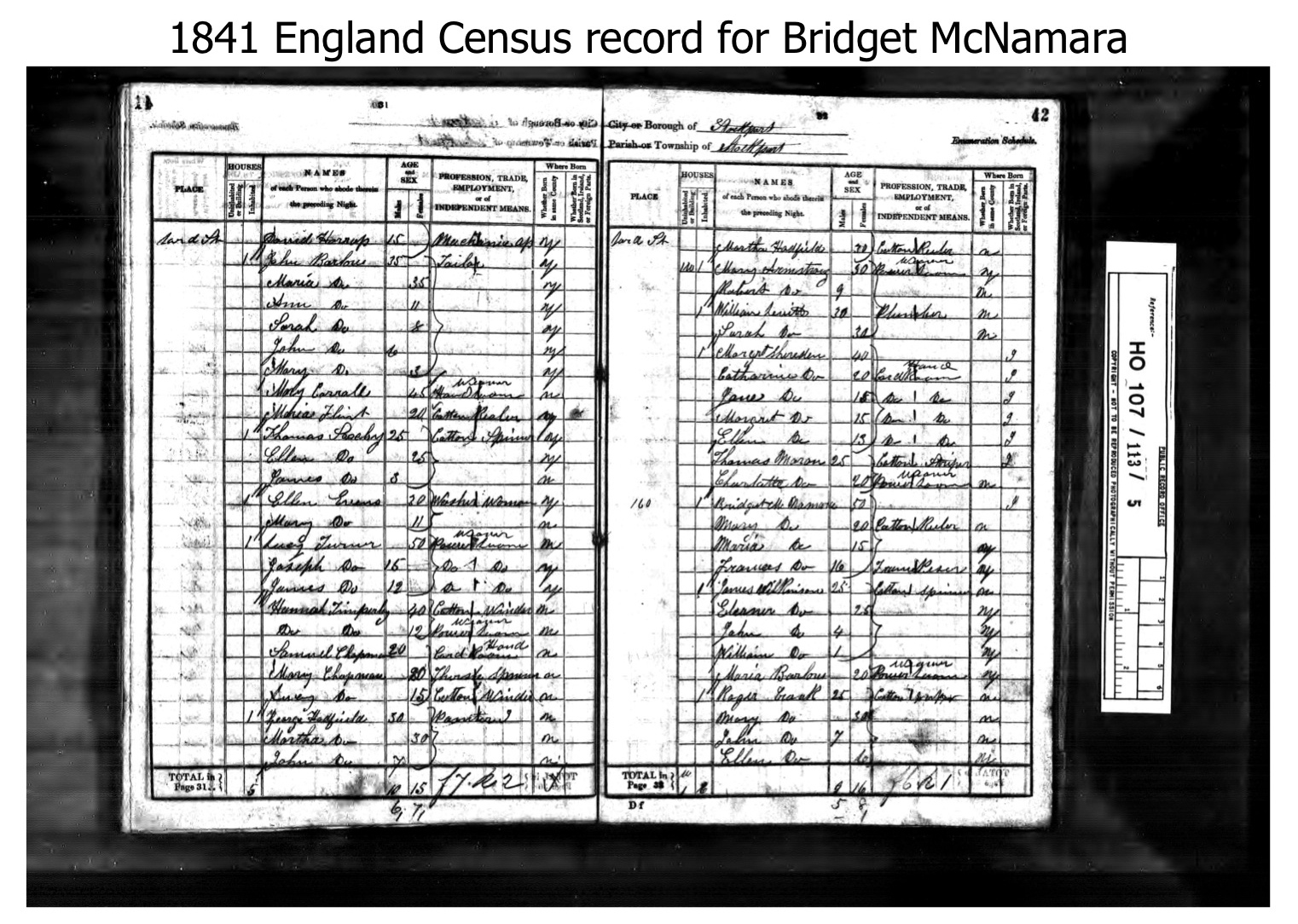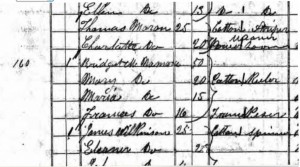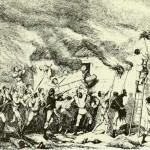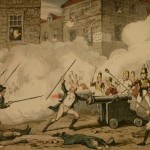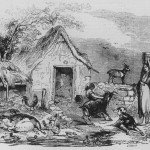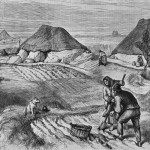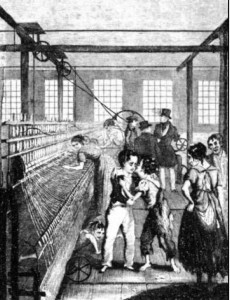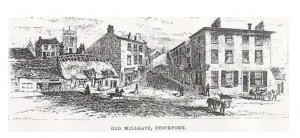McNamara Irish Roots
THE IRISH FOREBEARS OF HENRY PEARSON MCNAMARA
This first part of the narrative focuses on Dad’s side of the family. There are four family lines that need to be investigated, eventually: the McNamaras; the Waterhouses; the Pearsons; and the Raeburns. The family tree, below, describes the family link to Ireland.
The McNamaras and their Irish Origins
To begin with I have attempted to trace what is known about the direct McNamara male line since the early 19th Century and its origins in Ireland. It needs to be emphasised that tracing our ancestry back to Ireland is difficult. There are no computerised Irish census records before 1901 or Births Marriages and Deaths records before 1864. In addition, there were no passenger ship records for Irish migrants sailing to England in the 19th Century. On the other hand, one can be reasonably certain that the family name must have originated in Ireland. ‘McNamara’ is an Irish name imported to England especially into the Lancashire region where our forebears settled.
We may assume that sometime in the past the McNamara name had its roots in the Irish Clan McNamara (see here)
The clan originated in County Clare in Ireland and was a common name in that region.
I had always thought that the gaelic name meant ‘son of the sea’ but authorities (for example see here) also give the meaning as ‘son of sea hound’ or ‘hound of the sea’ which sounds much more dramatic. Pirates? There are alternative spellings for the name (see here) including MacNamara , McNamar, McNamarra, and McNamard. I had assumed that different ways of spelling the name on early censuses were errors but they may have been intended.
As far as the male surname McNamara is concerned, on the basis of what I have been able to discover it would appear that:
(i) A male William McNamara, (details unknown) married Bridget McNamara (maiden name unknown) born in Ireland in about 1791. The couple migrated to Lancashire and begat:
(ii) Francis McNamara born in 1826/7 in Stockport. In 1850/1 he married Elizabeth and they begat:
(iii) Francis William McNamara born in Stockport in about 1855. He married Mary Waterhouse in 1875 at Fylde and they later moved to County Durham. They begat:
(iv) Francis, later called Frank McNamara, born in 1884 at Aukland. He married Susannah Pearson in 1909 at Aukland. They begat:
(v) Henry Pearson McNamara, born at Bishop Aukland in 1910. He married Alice Muriel Stringer at Oxford in 1937. They begat:
(vi) David, Frank, Ian and Hugh McNamara, the first three of whom married and have had eight children between them who thus far have not managed to begat a male child to continue the McNamara name – if it matters to anybody.
To develop the story in more detail. The first of ‘our’ McNamaras who can be clearly identified without doubt as our forebear is Francis McNamara who was born at Stockport (see the map above) in 1826/7 and who died in the Fylde Registration District in 1903. I am now reasonably confident that he provides the link to our Irish roots.
It is the census evidence, above, which provides the link with Ireland . The mother of Francis is named Bridget and her census entry is on the left hand census page next to 160 (see above). The poor quality of the original record illustrates how difficult it can be to read old census pages and identify family forebears (see the enlarged image below).
For the sake of clarity the modern transcription of the census page can be seen here as a PDF, Bridget McNamara.
On the first official census, the 1841 Census (see above), our forebear was listed as Frances (or possibly with a double ‘ee’) McNamara and recorded as being born in about 1825 at Cheshire. He was living with his family at Stockport. His family consisted of his Mother, Bridget, born in Ireland in about 1791 and his two sisters, Mary, 20, born about 1821 and Maria, 15, born about 1825, both of whom were born at Stockport. Presumably Father McNamara had died or gone missing. However, Bridget clearly provides the link back to Ireland. One may assume that her husband was from Ireland but even if one cannot be sure of this the mother does provide the link with Irish ancestry.
I am confident that this record is correct and I have cross checked with other searches on line. But one should note that there are two very slight concerns which could lead one to question the link. The first is the change of spelling from Frances to Francis on later censuses. However, the spelling of this Christian name was inconsistent in the 19th Century; the alternative ‘es/is’ spellings were not linked to gender as they are nowadays. In any case a person’s sex is always noted on the census form. Furthermore, when one examines the original census sheet it is evident that there is a number of minor errors on that particular census document which cause one to query the accuracy of the original information and its transfer to the official census record by the clerk. Also at times the clerk’s handwriting is unclear. On the census sheet for the McNamara entry the name seems to be spelt ‘Francees’ or ‘Franies’. One wonders what Bridget or another family member recorded for the original form, assuming they were literate. The second concern is that Frances’s birth date is given as 1825 rather than 1826. In this respect there is another entry error for the McNamara family on the Census. Children must be listed in birth order on census forms but the McNamara entry reads:
Mary age 20 born about 1821
Maria age 15 born about 1826
Frances age 16 born about 1825
Presumably Bridget knew the correct birth order of her children which means that the year 1825 should have been entered above 1826 which would give Frances his correct birth date. The girls’ names Maria and Mary indicate a strong Irish and Catholic influence. To play devil’s advocate, another possible objection is that the name Bridget does not continue in the family. This can be countered by pointing out that in the next generation daughters’ names are linked to siblings or relatives on the distaff side of their families. Finally, when one runs the record forward this ‘Frances/is’ is the only one who had a clear link to later 19th Century census data, which is undoubtedly correct, and with the next generations of ‘our’ McNamaras. Thus, so long as one sets aside these minor concerns all the cross checks indicate that Bridget’s son is our forebear and roots the family’s origins in Ireland. Moreover, an examination of the geographical spread of McNamara heads of households in Lancashire in the first part of the 19th Century clearly indicates that the overwhelming majority of McNamara families living in the region came from Ireland.
The record I have established does seem reasonably watertight because on the Ancestry records there is a quite separate search, see the PDF Francis McNamara, which replicates my account and moreover gives Bridget’s husband’s name as William. This does tie in because the second name of her son, Frances, is William and this name is passed on to his son as well.
(It is of course possible that Bridget could have migrated to Lancashire on her own and married a McNamara after her arrival. It is, however, unlikely that a single girl would have traveled from Ireland on her own. Even if there is a remote chance that she did, it would still be the case that she provides the family link to Ireland and presumably her husband would have been a McNamara who had arrived separately from Ireland.)
Mary, the eldest daughter of Bridget and William, was born in England in 1821. Thus we may assume that Bridget and her McNamara husband emigrated from Ireland before that date. But in 1821 Bridget would have been aged about 30, rather old at that time for the birth of a first child. In that era fecund females tended to get married and have their first child in their early twenties or before. So it is reasonable to assume that the parents arrived from Ireland sometime during the second decade of the century since the children listed on the census were born in England. By 1841 any of Bridget’s older children would probably have left the family home.
This links Bridget’s family with the first important wave of migration from Ireland (see here) to England which began after the Irish rebellion in 1798, see here and here. During the early part of the 19th Century there was a substantial influx of Irish immigrants into North-West England. By the 1810s, for instance, there was a well established Irish community in Liverpool.
The Irish Rebellion
- Irish rebellion 1798
- Continuing

The motive for Bridget and her McNamara husband to migrate to England could have been religious persecution after 1798 or poverty. Personally I question whether it could have been religious persecution. Bridget named her daughters with the traditional Catholic Christian names of Mary and its alternative form, Maria. It was persecution against protestants which disposed Irish families to move to England. I suspect that it is more likely to have been poverty. At that time the average Irish agricultural wage was eight old pence per day. Upon arrival in England the majority of Irish migrants worked in factories or as navvies.
Irish Poverty Contemporary Illustrations
- Irish rural poverty early 1800s
- Small farms dependent on one crop
It was probably work in the burgeoning cotton manufacture industry which had attracted the family to Lancashire or at least provided their employment when the arrived on the mainland. In 1841 Mary and Maria were employed as cotton ballers – workers who wound cotton thread into balls on a special balling machine. These were used in ‘Ball Warping’, the oldest system of warping at the time. Frances was a frame spinner – someone who tended a machine for spinning cotton threads.
Bridget died in Stockport in 1843. (This does illustrate how investigating family history can often depend on chance and a lucky break. If Bridget had died before the completion of the 1841 Census we would not know anything of her story and could not establish the link back to Ireland.)
As a speculative aside the fate of Bridget’s husband cannot be determined. The obvious conclusion is that he died before the 1841 Census was carried out. Alternatively it is possible that he had left his family and was still alive. If we assume that his name was William or Francis and make reasonable assumptions about his birth date and place of birth it is possible to find possible candidates for Bridget’s husband. For instance on the 1861 Census there is a William McNamara who fits the husband’s profile living at Skifnal, Shropshire. He was aged seventy and working as as a Stockman. There is also a Francis or two who fit the profile. Unfortunately they were convicted and finished up on convict ships bound for Australia.

